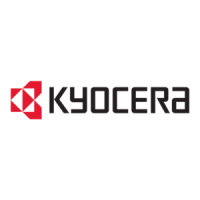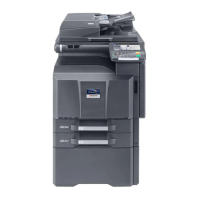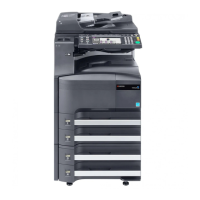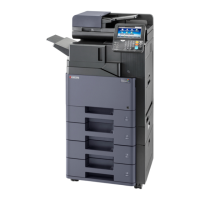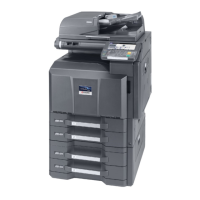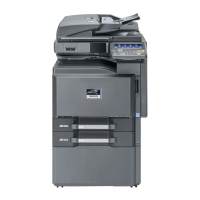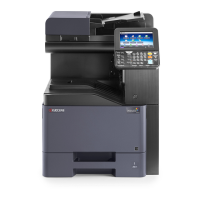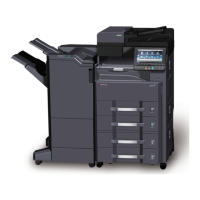




Do you have a question about the Kyocera TASKalfa 3050ci and is the answer not in the manual?
Identifies operation panel keys and their functions.
Details the procedure for turning the machine's power on and off, including sleep mode recovery.
Details the procedure for setting up the network connection using a LAN cable.
Explains how to install necessary software from the Product Library DVD onto your PC.
Provides instructions on how to load paper into the various cassettes and trays.
Explains how to place originals on the platen or in the document processor for scanning.
Provides step-by-step instructions for performing basic copying operations.
Details the options for producing two-sided copies from one-sided or two-sided originals.
Enables pausing current jobs to make immediate copies, then resuming paused jobs.
Provides instructions on how to staple finished copies using the optional finisher.
Explains how to punch holes in copies for preparation of binding.
Explains how to send scanned images via E-mail, to a PC, or to a Document Box.
Details how to send scanned originals as E-mail attachments.
Explains how to store scanned images in shared folders on a PC or FTP server.
Details information needed on the machine and PC for receiving documents.
Instructions on how to specify destinations using the Address Book or One Touch Keys.
Explains how to utilize the Document Box for storing and retrieving documents.
Describes how to create, edit, and manage custom boxes for document storage.
Provides steps to cancel any print or send job that is currently executing.
Selects the paper source that contains the required paper size for copying.
Guides on printing documents directly from application software.
Explains how Job Box stores print data for later printing from the operation panel.
Selects the size of originals for scanning, ensuring proper basis for scanning.
Selects the size of the image to be sent, aligning with original or paper dimensions.
Restricts access levels for PDF files by assigning secure passwords.
Adjusts the density when scanning originals, available in 13 levels.
Explains creating, editing, and managing custom boxes for document storage.
Provides instructions on printing documents stored in a custom box.
Explains how to send documents stored in a custom box.
Explains Private Print/Stored Job and Proof and Hold Print Box functions.
Guides on printing files stored in USB memory directly from the machine.
Allows storing scanned image files in USB memory.
Checks the status of jobs being processed or waiting to be printed.
Checks the history of completed jobs.
Pauses and resumes all printing jobs that are in printing or waiting status.
Checks the remaining amounts of toner, paper, and staples on the touch panel.
Configures or checks the status of devices and lines installed or connected.
Selects paper sizes and media types for cassettes and feeders.
Selects paper sizes and media types for the multi-purpose tray.
Selects actions for errors like duplexing, finishing, or paper jams.
Selects the enlarged/reduced default settings for zoom.
Sets default options for copying functions.
Specifies sending function options like Quick Setup and Destination Check.
Sets the address to which transmission copies are forwarded.
Selects the default file format for forwarded transmission copies.
Covers toner container replacement and cleaning of related parts.
Provides steps for replacing toner containers, including cleaning.
Guides on replacing the waste toner box when it becomes full.
Instructions for refilling staple cartridges in optional finishers.
Details regular cleaning procedures for machine parts to ensure output quality.
Provides general guidelines for problem solving, with symptoms, checkpoints, and corrective actions.
Troubleshooting steps for paper jams in various locations like cassettes and feeders.
Troubleshooting for issues preventing the machine from printing.
Troubleshooting steps for SMB sending errors, including network and folder settings.
Provides corrective actions for various alphanumeric error messages displayed on the touch panel.
Addresses errors when the machine cannot find the destination computer.
Addresses errors related to the hard disk, including space and damage.
Troubleshooting when printing count exceeds acceptable limits.
Troubleshooting for errors that occur during transmission.
Guides on removing jammed staples.
Provides instructions to clear paper jams in various machine components.
Instructions to clear paper jams in the fixing unit.
Guides to clear paper jams in the optional document processor.
Follows steps to remove jammed staples from the finisher.
Specifies how user access is administered, including login name and password.
Enables user login administration, selecting authentication methods like Local or Network.
Adds new users to the local user list, defining properties and privileges.
Allows modification of user properties based on access privilege.
Sets machine usage restrictions for groups registered in the authentication server.
Sets required information to obtain network user property from LDAP server.
Enables logging in by simply selecting a previously registered user.
Manages copy/print counts by assigning IDs to accounts.
Enables job accounting and specifies the setting.
Handles account ID entry and login/logout when job accounting is enabled.
Explains how to add a new account for job accounting.
Changes registered account information or deletes accounts.
Selects how copying and printing page counts are shown (total or individual).
Restricts machine use by account or number of sheets available.
Counts printed pages, classified into Total Job Accounting and Each Job Accounting.
Counts pages for all accounts and resets counters together.
Counts pages for each account and resets counts by account.
Describes the 1,000-sheet finisher's capabilities for print runs, separating, offsetting, and stapling.
Details the large-capacity finisher for print runs, separating, offsetting, stapling, and hole-punching.
Explains paper sizes and types that can be used in the paper source.
Lists the specifications of paper supported by the machine.
Provides detailed specifications for the machine, printer, and scanner.
Details specifications for the machine's type, printing method, and paper handling.
Lists specifications for printing, including speed, resolution, and interface.
Details system requirements, resolution, file formats, and scanning speed.
Specifications for the 1,000-sheet finisher, including paper size and stapling.
Details specifications for the 4,000-sheet finisher, including paper size and stapling.
Identifies operation panel keys and their functions.
Details the procedure for turning the machine's power on and off, including sleep mode recovery.
Details the procedure for setting up the network connection using a LAN cable.
Explains how to install necessary software from the Product Library DVD onto your PC.
Provides instructions on how to load paper into the various cassettes and trays.
Explains how to place originals on the platen or in the document processor for scanning.
Provides step-by-step instructions for performing basic copying operations.
Details the options for producing two-sided copies from one-sided or two-sided originals.
Enables pausing current jobs to make immediate copies, then resuming paused jobs.
Provides instructions on how to staple finished copies using the optional finisher.
Explains how to punch holes in copies for preparation of binding.
Explains how to send scanned images via E-mail, to a PC, or to a Document Box.
Details how to send scanned originals as E-mail attachments.
Explains how to store scanned images in shared folders on a PC or FTP server.
Details information needed on the machine and PC for receiving documents.
Instructions on how to specify destinations using the Address Book or One Touch Keys.
Explains how to utilize the Document Box for storing and retrieving documents.
Describes how to create, edit, and manage custom boxes for document storage.
Provides steps to cancel any print or send job that is currently executing.
Selects the paper source that contains the required paper size for copying.
Guides on printing documents directly from application software.
Explains how Job Box stores print data for later printing from the operation panel.
Selects the size of originals for scanning, ensuring proper basis for scanning.
Selects the size of the image to be sent, aligning with original or paper dimensions.
Restricts access levels for PDF files by assigning secure passwords.
Adjusts the density when scanning originals, available in 13 levels.
Explains creating, editing, and managing custom boxes for document storage.
Provides instructions on printing documents stored in a custom box.
Explains how to send documents stored in a custom box.
Explains Private Print/Stored Job and Proof and Hold Print Box functions.
Guides on printing files stored in USB memory directly from the machine.
Allows storing scanned image files in USB memory.
Checks the status of jobs being processed or waiting to be printed.
Checks the history of completed jobs.
Pauses and resumes all printing jobs that are in printing or waiting status.
Checks the remaining amounts of toner, paper, and staples on the touch panel.
Configures or checks the status of devices and lines installed or connected.
Selects paper sizes and media types for cassettes and feeders.
Selects paper sizes and media types for the multi-purpose tray.
Selects actions for errors like duplexing, finishing, or paper jams.
Selects the enlarged/reduced default settings for zoom.
Sets default options for copying functions.
Specifies sending function options like Quick Setup and Destination Check.
Sets the address to which transmission copies are forwarded.
Selects the default file format for forwarded transmission copies.
Covers toner container replacement and cleaning of related parts.
Provides steps for replacing toner containers, including cleaning.
Guides on replacing the waste toner box when it becomes full.
Instructions for refilling staple cartridges in optional finishers.
Details regular cleaning procedures for machine parts to ensure output quality.
Provides general guidelines for problem solving, with symptoms, checkpoints, and corrective actions.
Troubleshooting steps for paper jams in various locations like cassettes and feeders.
Troubleshooting for issues preventing the machine from printing.
Troubleshooting steps for SMB sending errors, including network and folder settings.
Provides corrective actions for various alphanumeric error messages displayed on the touch panel.
Addresses errors when the machine cannot find the destination computer.
Addresses errors related to the hard disk, including space and damage.
Troubleshooting when printing count exceeds acceptable limits.
Troubleshooting for errors that occur during transmission.
Guides on removing jammed staples.
Provides instructions to clear paper jams in various machine components.
Instructions to clear paper jams in the fixing unit.
Guides to clear paper jams in the optional document processor.
Follows steps to remove jammed staples from the finisher.
Specifies how user access is administered, including login name and password.
Enables user login administration, selecting authentication methods like Local or Network.
Adds new users to the local user list, defining properties and privileges.
Allows modification of user properties based on access privilege.
Sets machine usage restrictions for groups registered in the authentication server.
Sets required information to obtain network user property from LDAP server.
Enables logging in by simply selecting a previously registered user.
Manages copy/print counts by assigning IDs to accounts.
Enables job accounting and specifies the setting.
Handles account ID entry and login/logout when job accounting is enabled.
Explains how to add a new account for job accounting.
Changes registered account information or deletes accounts.
Selects how copying and printing page counts are shown (total or individual).
Restricts machine use by account or number of sheets available.
Counts printed pages, classified into Total Job Accounting and Each Job Accounting.
Counts pages for all accounts and resets counters together.
Counts pages for each account and resets counts by account.
Describes the 1,000-sheet finisher's capabilities for print runs, separating, offsetting, and stapling.
Details the large-capacity finisher for print runs, separating, offsetting, stapling, and hole-punching.
Explains paper sizes and types that can be used in the paper source.
Lists the specifications of paper supported by the machine.
Provides detailed specifications for the machine, printer, and scanner.
Details specifications for the machine's type, printing method, and paper handling.
Lists specifications for printing, including speed, resolution, and interface.
Details system requirements, resolution, file formats, and scanning speed.
Specifications for the 1,000-sheet finisher, including paper size and stapling.
Details specifications for the 4,000-sheet finisher, including paper size and stapling.
| Print technology | Laser |
|---|---|
| Time to first page (black, normal) | 6.2 s |
| Time to first page (color, normal) | 8.1 s |
| Print speed (black, normal quality, A3) | 15 ppm |
| Print speed (black, normal quality, A4/US Letter) | 30 ppm |
| Copier resize | 25 - 400 % |
| PC free copying | Yes |
| Maximum copy resolution | 600 x 600 DPI |
| Maximum number of copies | 999 copies |
| N-in-1 copy function (N=) | 2, 4 |
| Scan to | E-mail, File, FTP, Image, OCR, USB |
| Scan drivers | TWAIN |
| Grayscale levels | 256 |
| Maximum scan area | A3 (297 x 420) mm |
| Image formats supported | JPG, TIF |
| Document formats supported | |
| Faxing | - |
| Fax memory | 12 MB |
| Modem speed | 33.6 Kbit/s |
| Fax coding methods | JBIG, MH, MMR (Fax coding method), MR |
| Fax transmission speed | 3 sec/page |
| Printing colors | Black, Cyan, Magenta, Yellow |
| Maximum duty cycle | - pages per month |
| Number of print cartridges | 4 |
| Page description languages | Microsoft XPS, PCL 5c, PCL 6, PCL XL, PostScript 3 |
| Paper input type | Cassette, Paper tray |
| Total input capacity | 1150 sheets |
| Total output capacity | 250 sheets |
| Maximum input capacity | 7150 sheets |
| Total number of input trays | 3 |
| Multi-Purpose tray input capacity | 150 sheets |
| Maximum print size | 305 x 1219 mm |
| Duplex media weight | 60 - 256 g/m² |
| Paper tray media types | Plain paper |
| Paper tray media weight | 60 - 220 g/m² |
| ISO A-series sizes (A0...A9) | A6 |
| Multi-Purpose Tray media weight | 60 - 300 g/m² |
| Display | LCD |
| Product color | Black |
| Market positioning | Business |
| Standard interfaces | USB 2.0 |
| Wi-Fi | No |
| Mobile printing technologies | Not supported |
| Processor model | 750CL |
| Processor family | PowerPC |
| Processor frequency | 600 MHz |
| Compatible memory cards | CF |
| Internal storage capacity | 160 GB |
| Sound power level (standby) | 40.2 dB |
| Sound pressure level (copying) | 49.9 dB |
| AC input voltage | 220 - 240 V |
| AC input frequency | 50 - 60 Hz |
| Power consumption (standby) | 200 W |
| Power consumption (PowerSave) | 17 W |
| Power consumption (average operating) | 900 W |
| Mac operating systems supported | Mac OS X 10.4 Tiger, Mac OS X 10.5 Leopard, Mac OS X 10.6 Snow Leopard, Mac OS X 10.7 Lion, Mac OS X 10.8 Mountain Lion |
| Server operating systems supported | Windows 2000 Advanced Server, Windows 2000 Server, Windows MultiPoint Server 2011, Windows SBS 2011 Essentials, Windows SBS 2011 Standard, Windows Server 2003, Windows Server 2003 R2, Windows Server 2003 x64, Windows Server 2008, Windows Server 2008 R2, Windows Server 2008 x64, Windows Server 2012 |
| Sustainability certificates | ENERGY STAR |
| Certification | GS, TUV, CE |
| Depth | 767 mm |
|---|---|
| Width | 668 mm |
| Height | 747 mm |
